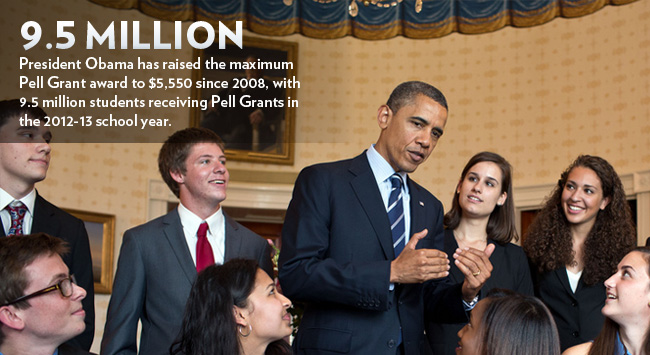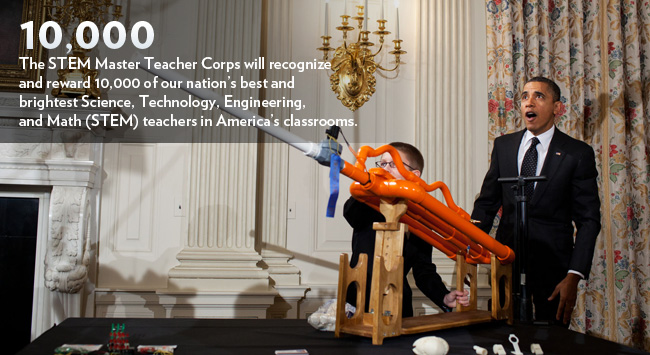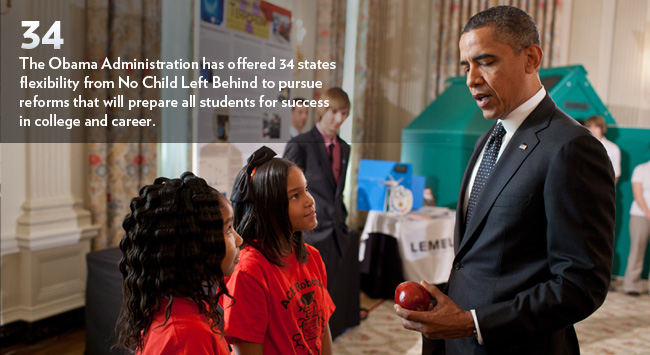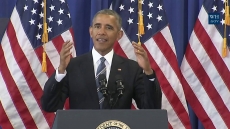EDUCATION
“If we want America to lead in the 21st century, nothing is more important than giving everyone the best education possible — from the day they start preschool to the day they start their career.”
Reform for the Future
The strength of the American economy is inextricably linked to the strength of America’s education system. Now more than ever, the American economy needs a workforce that is skilled, adaptable, creative, and equipped for success in the global marketplace.
America’s ability to compete begins each day, in classrooms across the nation—and President Obama knows we must comprehensively strengthen and reform our education system in order to be successful in a 21st century economy. The case for the link between the strength of American education and the strength of our economy is a simple one—and it is one that all Americans can agree on. Ensuring that every student in our country graduates from high school prepared for college and a successful career is central to rebuilding our economy and securing a brighter economic future for all Americans.
Race to the Top

Race to the Top marks a historic moment in American education. This initiative offers bold incentives to states willing to spur systemic reform to improve teaching and learning in America’s schools. Race to the Top has ushered in significant change in our education system, particularly in raising standards and aligning policies and structures to the goal of college and career readiness. Race to the Top has helped drive states nationwide to pursue higher standards, improve teacher effectiveness, use data effectively in the classroom, and adopt new strategies to help struggling schools.
Redesigning and Reforming No Child Left Behind

As states move forward with education reforms, some provisions of No Child Left Behind—the most current version of the Elementary and Secondary Education Act, which is five years overdue for reauthorization—stand in the way of their progress. Although NCLB started a national conversation about student achievement, unintended consequences of NCLB have reinforced the wrong behaviors in attempting to strengthen public education. NCLB has created incentives for states to lower their standards; emphasized punishing failure over rewarding success; focused on absolute scores, rather than recognizing growth and progress; and prescribed a pass-fail, one-size-fits-all series of interventions for schools that miss their goals.
In March of 2010, the Obama Administration sent Congress a Blueprint for Reform of the Elementary and Secondary Education Act, addressing the issues created by No Child Left Behind while pursuing high standards and closing the achievement gap. But because Congress has not acted to reauthorize ESEA, the Administration moved forward in providing states flexibility within the law — as authorized by provisions in the law itself — to pursue comprehensive plans to improve educational outcomes for all students, close achievement gaps, and improve the quality of teaching. To date, 33 states and the District of Columbia have received ESEA flexibility.
Fortifying Science, Technology, Engineering and Math (STEM)Education

The President has consistently called for improvements in STEM education to move America’s students to the top of the pack by enabling all students to learn deeply and think critically in science and math; expanding STEM education opportunities for students from all backgrounds; and building partnerships among educators, businesses and community partners to support advances in STEM education. This Administration has promoted several successful STEM initiatives, including prioritizing STEM education in Race to the Top and the Investing in Innovation Fund; improving the coordination of STEM education initiatives between the Department of Education and NSF; and promoting over 100 industry partners in their efforts to boost STEM learning through Change the Equation.
We have focused our STEM agenda further in 2012 to address the following two goals:
- Excellent teachers, with content knowledge, mastery of how to teach that content, and ability to motivate students in STEM subjects and careers; and
- Improving undergraduate STEM teaching, setting a trajectory of producing one million additional STEM degrees over the next decade, as recently recommended by the President’s Council of Advisors on Science and Technology..
The President has issued a national challenge to prepare 100,000 effective STEM teachers and has requested $80 million for a competition by the Department of Education to support effective STEM teaching preparation programs.
Also in advancement of this goal, the President has proposed the creation of a new, national Science, Technology, Engineering and Math (STEM) Master Teacher Corps comprised of some of the nation’s finest educators in STEM subjects. The STEM Master Teacher Corps will begin with 50 exceptional STEM teachers established in 50 sites and will be expanded over 4 years to reach 10,000 Master Teachers. These selected teachers will make a multi-year commitment to the Corps and, in exchange for their expertise, leadership and service, will receive an annual stipend of up to $20,000 on top of their base salary. The Administration will launch this Teacher Corps with the $1 billion from the President’s 2013 budget request currently before Congress.
Girls in STEM: A New Generation of Women in Science

Sparking Innovation

President Obama believes that education is a cornerstone of creating an American economy built to last. Building a world-class education system and high-quality job training opportunities will equip the American economy to advance business growth, encourage new investment and hiring, spark innovation, and promote continued economic growth and prosperity. Through several critical investments at the K-12 level, the Administration is fostering the type of growth, innovation, and transformation that is needed to improve our schools and achieve better outcomes for high-need students.
Turning Around Failing Schools
Since the beginning of his Administration, the President has dedicated over $4 billion to implement the bold reforms needed to transform the lowest-performing schools in America. Title I School Improvement Grants provide up to $6 million per school over three years to dramatically transform these lowest-performing schools into safe learning environments where students can thrive. The funding has been awarded to school districts in all 50 states as well as the District of Columbia, Puerto Rico, and the Bureau of Indian Education to turn around the lowest-performing schools in each state. More than 1,300 schools across the country are undertaking one of four options for dramatically changing the way they serve students, all requiring schools to institute far-reaching changes to improve student learning. School leaders, teachers, and community members are working together to build schools where teachers and students want to be and want to learn.
Investing in Innovation
The Investing in Innovation (i3) Fund supports research-based programs that help close achievement gaps and improve outcomes for high-need students. The i3 program invests in innovative practices in school districts, nonprofits, and institutions of higher education that are demonstrated to have an impact on improving student achievement, closing achievement gaps, decreasing dropout rates, increasing high school graduation rates, or increasing college enrollment and completion rates. These grants allow educational innovation to expand and develop, working in partnership with the private sector and the philanthropic community to identify and document best practices that can be shared and taken to scale based on demonstrated success. To date, $800 million in funding has been provided to more than 70 grantees to develop, validate, and scale up innovative reforms, with $150 million additional available in the 2012 competition.
Transforming Communities for Learning
The Promise Neighborhoods program takes a comprehensive approach to ensure that children have access to a continuum of educational and community supports. Modeled after the success of the Harlem Children's Zone, the Promise Neighborhoods program supports cradle-to-career services to improve educational outcomes for students in distressed high-poverty neighborhoods. These grants provide critical support for the planning and implementation of comprehensive services ranging from early learning, K-12, to college and career, including programs to improve the health, safety, and stability of neighborhoods, as well as to boost family engagement in student learning and improve access to learning technology. The Promise Neighborhoods program fits into a broader agenda for neighborhood revitalization – a strategy to focus not just on programs and policies, but on people and places – by knitting together all of the possible assets of a neighborhood. To date, the Promise Neighborhoods program has put $40 million into the community to make these initiatives come to life, and in 2012, $60 million is available to support up to 21 grants.
Re-envisioning Career and Technical Education
Effective Career and Technical Education (CTE) programs are aligned with college- and career-readiness standards – as well as the needs of employers, industry, and labor – in order to provide students with curricula that combines integrated academic and technical content, strong employability skills, and work-based learning opportunities that connect learning to real-life career scenarios. Last April, the Administration articulated a vision for strengthening and reforming CTE nationwide through the release of a Blueprint for Transformation of the Carl D. Perkins Career and Technical Education Act. In the Blueprint, the Administration laid out a plan to educate our way to an economy built to last by graduating more of our high school students prepared for college and career through effective CTE programs. These programs equip students with the skills they need to succeed in high-growth, high-wage jobs of the 21st century, and they empower American employers with a skilled, experienced, and sustainable workforce to support economic growth.
Ensuring Opportunity for All
![]()
This Administration is committed to taking on the ambitious work of closing the achievement gap and turning around America’s lowest-performing schools, while providing flexibility to states to develop new and innovative policies that will better drive better outcomes in their schools and to prepare their students to achieve the high standards we’ve set out. Secretary Duncan and the President have both called education the civil right issue of our generation. And we know that only by strengthening and expanding educational opportunities for all students — from cradle to career — can we reach the goals that the President has set out for us, and provide a word-class education to all of America’s students.
In February 2011, the Department of Education established the Equity and Excellence Commission — comprised of 27 members from a range of backgrounds including education, law, tax, government, business, and civil rights — that is tasked with examining disparities in meaningful educational opportunities that give rise to the achievement gap and recommending ways in which federal policies could address such disparities. The Commission will release a final report, summarizing findings and recommendations to inform policies aimed at gaps in student learning outcomes and strengthening public education for all students.
Strengthening the Teaching Profession

President Obama knows that teachers matter. The Administration has worked across several initiatives to support teachers, including by recruiting top talent to the profession, increasing accountability of teacher preparation programs, supporting the rethinking of traditional compensation and advancement models, promoting educator collaboration, and re-engaging communities in their schools.
Together with Education Secretary Arne Duncan, President Obama launched The RESPECT Project, which stands for Recognizing Educational Success, Professional Excellence, and Collaborative Teaching, with the goal of working with teachers, school and district leaders, teachers’ associations and unions, and state and national education organizations to spark a dialogue that results in strong policy and a sustainable transformation of the teaching profession. To implement the principles of The RESPECT Project, the Administration is proposing a new $5 billion grant program to support states and districts that commit to pursuing bold reforms at every stage of the teaching profession.
Developing effective evaluation and support systems has been a central part of the Administration’s work to strengthen the teaching profession. Our ESEA reauthorization proposal, ESEA flexibility package, Race to the Top initiative, School Improvement Grant program, and the Teacher Incentive Fund all support the development of strong systems of educator evaluation and support. Once fair, rigorous evaluations for teachers and leaders are in place, they can serve as a foundation for connecting educator performance with differentiated professional development, compensation, and career advancement.
To better support the preparation and development of successful teachers, the Department has also proposed setting aside 25 percent of Title II funds under No Child Left Behind (roughly $600 million) to improve teacher and leader recruitment, preparation, and professional development. The set-aside would support programs that recruit talented candidates into the teaching profession and provide them with rigorous training to prepare them for high-need schools. It would also support programs that recruit and train principals and school leadership teams to turn around the lowest performing schools.






